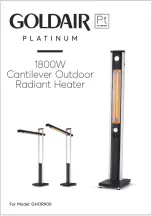
51
Never use this water heater unless it is completely filled with water.
To prevent damage to the tank, the tank must be filled with water.
Water must flow from the hot water faucet before turning “ON” gas
to the water heater.
A *Condensation may be seen on pipes in humid weather or pipe
connections may be leaking.
B. *The anode rod fitting may be leaking.
C. Small amounts of water from temperature-pressure relief valve
may be due to thermal expansion or high water pressure in your
area.
D. *The temperature-pressure relief valve may be leaking at the
tank fitting.
E. Water from a drain valve may be due to the valve being slightly
opened.
F. *The drain valve may be leaking at the tank fitting.
G. Leakage from recirculation plug or pipe connection.
H. Leakage from the plug under the cleanout cover.
I. Leakage from the temperature probe connection (Not shown in
figure).
J. Condensate from the exhaust connection.
Leakage from other water heaters, water lines, or ground seepage
should also be checked.
* To check where threaded portion enters tank, insert cotton
swab between jacket opening and fitting. If cotton is wet, follow
“Draining” instructions in the “Periodic Maintenance” section and
then remove fitting. Put pipe dope or teflon tape on the threads
and replace. Then follow “Filling the Water Heater” instructions
in the “Installing the New Water Heater” section.
LEAKAGE CHECKPOINTS
Figure: 39
A:Inlet &
Outlet
B:Anode
Rod
Connection
G:Recirculation
Connection
C:T & P
Connection
D:T & P Outlet
G:Recirculation
Connection
J:Flue Outlet
F:Drain Valve
Connection
H:Cleanout
E:Drain
Valve










































